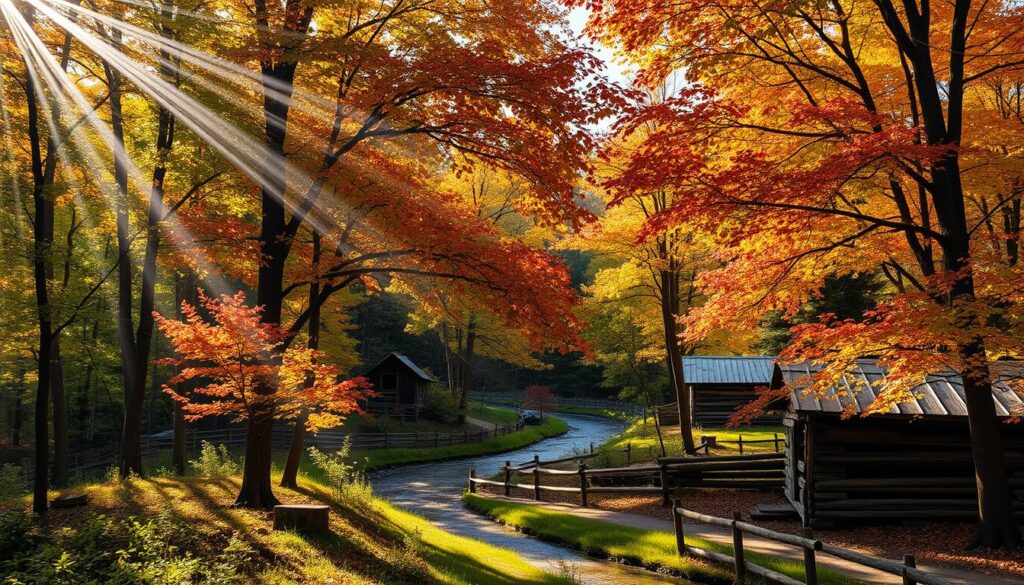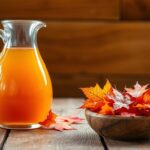In Michigan’s lush forests, pure Michigan maple syrup is like liquid gold. It captures the essence of the Great Lakes region. This natural sweetener tells a story of tradition, craftsmanship, and Michigan’s unique landscape.
Michigan maple syrup is special because of its unique flavor and careful harvesting. The state’s dense maple forests are perfect for making top-notch syrup. Sugarmakers tap sugar maple trees during the winter-to-spring transition, collecting sap that turns into rich, amber syrup.
The syrup’s journey starts with cold nights and warm days that make sap flow. Skilled producers carefully extract this precious liquid. Each drop is a result of generations of Michigan families mastering maple syrup production.
Michigan maple syrup is more than just sweet. It holds cultural significance, connecting local communities to their heritage. From Native American traditions to modern practices, it plays a key role in the region’s agriculture.
Food lovers and home cooks see Michigan maple syrup as a quality commitment. It shows a dedication to the environment and preserving a traditional craft. It celebrates the natural wealth of the Great Lakes state.
The Rich Heritage of Michigan Maple Syrup Production
The story of michigan maple syrup is deeply rooted in the landscapes and traditions of the Great Lakes region. Native American communities were the first to discover the magical transformation of maple tree sap into a sweet, golden nectar. This nectar would become a cherished culinary treasure.
Early indigenous tribes developed innovative techniques for collecting and processing maple sap long before European settlers arrived. They made strategic cuts in maple trees and used wooden spouts to collect the precious liquid. This showed remarkable understanding of natural resource management.
Native American Origins and Maple Syrup Harvesting
- Utilized birch bark containers for sap collection
- Used heated stones to boil and concentrate sap
- Recognized maple groves as sacred economic resources
Evolution of Authentic Michigan Maple Syrup Production
As settlers arrived in Michigan, they learned and adapted traditional maple syrup techniques. The development of metal tools and more efficient boiling methods transformed the production process. This made authentic michigan maple syrup a valuable agricultural product.
| Era | Production Method | Key Innovations |
|---|---|---|
| Native American Period | Wooden spouts, stone boiling | Seasonal harvesting techniques |
| Early Settler Period | Metal containers, wood-fired evaporators | Improved sap collection methods |
| Modern Era | Mechanized systems, vacuum extraction | Large-scale production capabilities |
Cultural Significance in the Great Lakes Region
Michigan maple syrup represents more than just a sweet condiment. It embodies a rich cultural narrative of resilience, innovation, and deep connection to the land. Local communities celebrate this tradition through maple festivals. They preserve the legacy of generations of skilled sugarmakers.
Why Michigan’s Geography Creates Perfect Syrup-Making Conditions
Michigan is a top spot for pure Michigan maple syrup. Its unique geography makes it perfect for growing maple trees. The state’s varied landscape and climate are ideal for making top-notch syrup.
- Abundant sugar maple forests covering approximately 3.9 million acres
- Optimal temperature ranges between 40-50 degrees Fahrenheit
- Consistent freeze-thaw cycles are key for sap production
- Rich, well-drained soil supports healthy maple trees
In Michigan, the northern regions are best for syrup. The Upper Peninsula and northern Lower Peninsula have special microclimates. These areas have big temperature changes that make the sap flow well.
“Michigan’s geography is nature’s perfect maple syrup laboratory” – Local Sugarmaker
The state’s landscape includes rolling hills, dense forests, and protected woodlands. These are great for sugar maple trees. Pure Michigan maple syrup gets better because of these natural factors. It’s known for its rich taste and consistent quality.
| Geographical Feature | Impact on Maple Syrup Production |
|---|---|
| Temperature Range | Triggers optimal sap flow |
| Forest Density | Provides protection and ideal growing conditions |
| Soil Composition | Supports healthy maple tree growth |
The Science Behind Pure Michigan Maple Syrup
Pure Michigan maple syrup is a mix of science and art. It starts as tree sap and turns into golden syrup. This process shows Michigan’s skill in farming.
Sap Collection: Nature’s Precise Timing
Michigan’s top maple syrup comes from careful sap collection in late winter and early spring. Sugarmakers watch the weather closely. They look for the right mix of warm days and cold nights to get the sap flowing:
- Daytime temperatures above 40°F
- Nighttime temperatures below freezing
- Specific weather conditions that create pressure changes in maple trees
Converting Sap to Liquid Gold
Turning sap into syrup is a slow and precise process. The sap is mostly water, with just 2% sugar. It needs to be boiled down to concentrate the sugar.
| Sap Stage | Sugar Content | Processing Time |
|---|---|---|
| Raw Sap | 2-3% | Initial Collection |
| Boiling Stage | 66-67% | 4-5 Hours |
| Finished Syrup | 66-67% | Final Product |
Maple Syrup Grade Classification
Michigan has a grading system for syrup. It helps people know the taste and quality of different syrups:
- Golden Color, Delicate Taste: Lightest grade, subtle flavor
- Amber Color, Rich Taste: Medium intensity, classic maple profile
- Dark Color, Robust Taste: Strong, pronounced maple flavor
“Every drop of pure Michigan maple syrup tells a story of tradition, science, and natural wonder.” – Michigan Maple Syrup Association
Sustainable Harvesting Practices in Michigan’s Sugar Bush
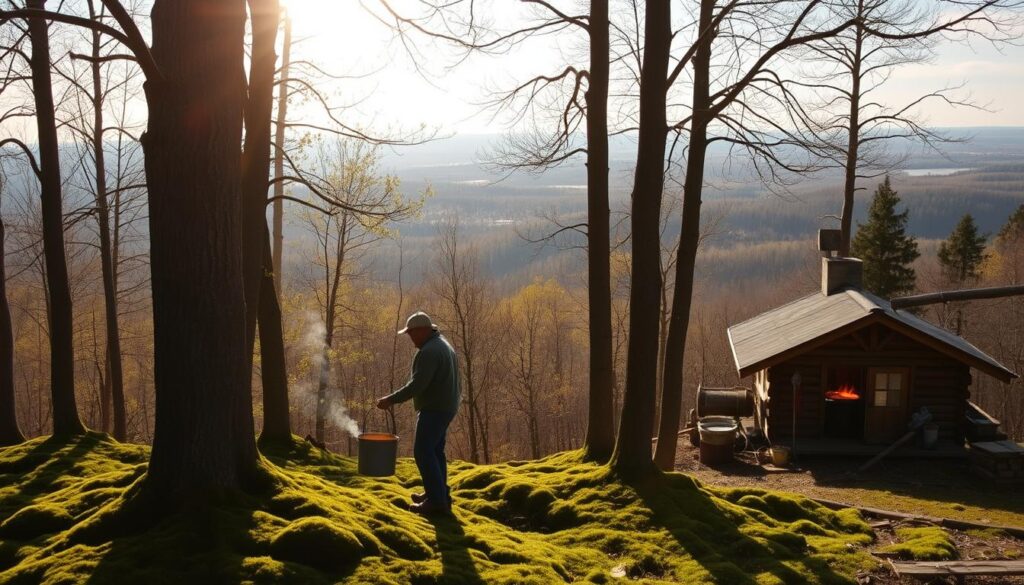
Michigan maple syrup makers lead in protecting sugar maple forests. They ensure quality syrup while caring for the environment. Their work in sustainable harvesting is a model for others.
At the heart of their work is keeping maple trees healthy. Organic producers in Michigan follow strict rules to reduce harm to the forest:
- Limit tapping to mature trees over 10 inches in diameter
- Use specialized tapping techniques that prevent tree damage
- Rotate tapping locations to allow tree recovery
- Maintain diverse forest ecosystems
Forest conservation is key to their work. Michigan sugarmakers use advanced systems to monitor tree health and sap flow. This helps protect trees and ensures sustainability for years to come.
| Sustainable Practice | Environmental Benefit | Impact on Syrup Quality |
|---|---|---|
| Selective Tree Tapping | Reduces forest stress | Maintains consistent syrup flavor |
| Forest Biodiversity Preservation | Supports ecosystem health | Enhances maple tree vitality |
| Energy-Efficient Processing | Reduces carbon footprint | Improves production sustainability |
Climate adaptation strategies are vital for Michigan maple syrup producers. They’re finding new ways to deal with environmental changes. This ensures the sugar maple forests stay healthy for future generations.
Michigan Maple Syrup: From Tree to Table
The journey of Michigan maple syrup is a mix of old traditions and new methods. It goes from the cold maple trees to your breakfast. Every drop of syrup is a story of skill and nature’s beauty.
Traditional vs Modern Production Methods
Michigan maple syrup makers use both old ways and new tech. They used wooden buckets and tapped trees by hand before. Now, they use advanced systems like vacuum tubes and computers to collect sap better.
- Traditional hand-tapping techniques
- Vacuum tube sap collection systems
- Computer-controlled evaporation processes
- Precision temperature monitoring
Quality Control Standards
Keeping Michigan maple syrup top-notch is a big deal. Producers follow strict rules to keep the syrup’s taste and quality high. They check every step, from collecting sap to bottling.
Packaging and Distribution
Michigan maple syrup is packed to keep its flavor strong. You can find it at local markets, special stores, and online. This makes it easy to buy directly from the makers.
Each bottle represents a commitment to preserving Michigan’s maple syrup heritage.
Top Michigan Maple Syrup Producing Regions
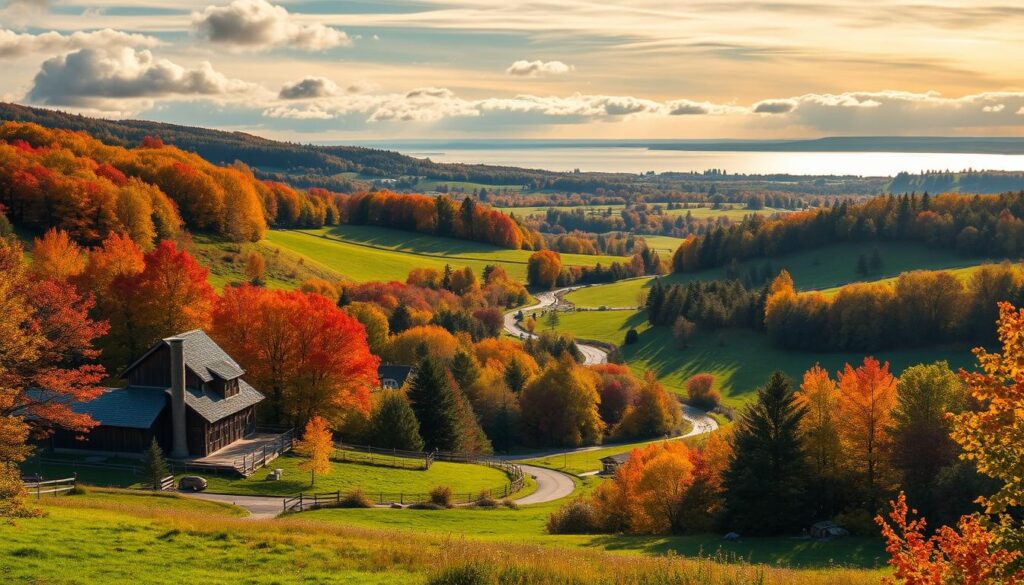
Michigan’s varied landscape is perfect for making top-notch michigan maple syrup. The northern parts of the state have a special maple syrup production area. This area is different from other places that make maple syrup.
Several key areas in Michigan are known for their maple syrup. Each area has its own special features that make the syrup taste different:
- Northern Lower Peninsula: Known for dense maple forests and ideal climate conditions
- Leelanau County: Renowned for exceptional sugar maple stands
- Charlevoix and Antrim Counties: Produce syrup with distinctive mineral undertones
Maple producers in these areas use their unique advantages:
- Cool nights and warm days trigger optimal sap flow
- Rich, well-drained soil supports robust maple tree growth
- Microclimates create nuanced flavor variations
“Each drop of michigan maple syrup tells a story of our landscape and tradition.” – Michigan Maple Syrup Association
The state is dedicated to sustainable harvesting. This ensures these regions keep making world-class maple syrup for years to come.
How to Choose Authentic Michigan Maple Syrup
Choosing the right authentic Michigan maple syrup is important. It’s about finding genuine products that show off Michigan’s maple heritage.
Finding the right michigan maple syrup for sale can be tricky. But knowing what to look for makes it easier.
Understanding Labels and Certifications
Spotting authentic michigan maple syrup means looking at a few key things:
- Look for state-specific Michigan maple syrup certifications
- Check for USDA grading standards
- Verify the producer’s name and location
- Confirm organic certifications when applicable
Storage Recommendations
Keeping your maple syrup in top shape is easy:
- Store unopened syrup in a cool, dark place
- Refrigerate after opening
- Use within one year for optimal flavor
- Check for crystallization or mold before consumption
Price Points and Value Assessment
| Syrup Grade | Price Range | Quality Indicators |
|---|---|---|
| Golden/Delicate | $12-$15 per 250ml | Lightest flavor, early season harvest |
| Amber/Rich | $15-$20 per 250ml | Medium intensity, most popular |
| Dark/Robust | $18-$25 per 250ml | Strong maple flavor, late season |
Pro tip: Higher price doesn’t always mean better quality. What matters most is how it’s made and the local reputation.
Organic Michigan Maple Syrup: What Sets It Apart
Organic Michigan maple syrup is the sweetest of them all. It stands out because of its strict production rules and love for the environment. This syrup is made with care, showing off Michigan’s rich farming history.
The process to get organic Michigan maple syrup is tough. It includes:
- Strict land management practices
- No synthetic chemical interventions
- Sustainable forest ecosystem preservation
- Comprehensive environmental monitoring
Michigan’s sugarmakers pick special forests for their syrup. These pristine woodland environments make the syrup truly special. It’s a taste of Michigan’s untouched beauty.
There are big differences between regular and organic maple syrup making:
- Ecological forest management
- Minimal processing techniques
- Preservation of biodiversity
- Reduced environmental impact
People who buy organic Michigan maple syrup help local farmers. They also get a healthier, greener sweetener. The hard work in getting this syrup shows Michigan’s dedication to green food.
Culinary Applications and Recipe Inspiration
Michigan maple syrup turns simple dishes into amazing meals. Its rich flavor makes both sweet and savory dishes better. It’s a key ingredient in kitchens across the Great Lakes.
Michigan maple syrup is more than just for pancakes. Chefs and home cooks find new ways to use it in their recipes.
Traditional Culinary Delights
- Classic breakfast dishes like French toast and waffles
- Homemade baked goods including maple cookies and muffins
- Traditional glazes for ham and breakfast meats
Modern Culinary Innovations
Creative cooks are using michigan maple syrup in new ways. Artisan chefs add it to:
- Craft cocktails and unique beverages
- Gourmet salad dressings
- Savory marinades for grilled meats
- Experimental dessert creations
Flavor Pairing Suggestions
The best michigan maple syrup goes well with:
- Roasted nuts
- Aged cheeses
- Smoky bacon
- Warm spices like cinnamon and nutmeg
“Maple syrup isn’t just a condiment—it’s a culinary adventure waiting to be explored.”
Economic Impact of Maple Syrup Production in Michigan
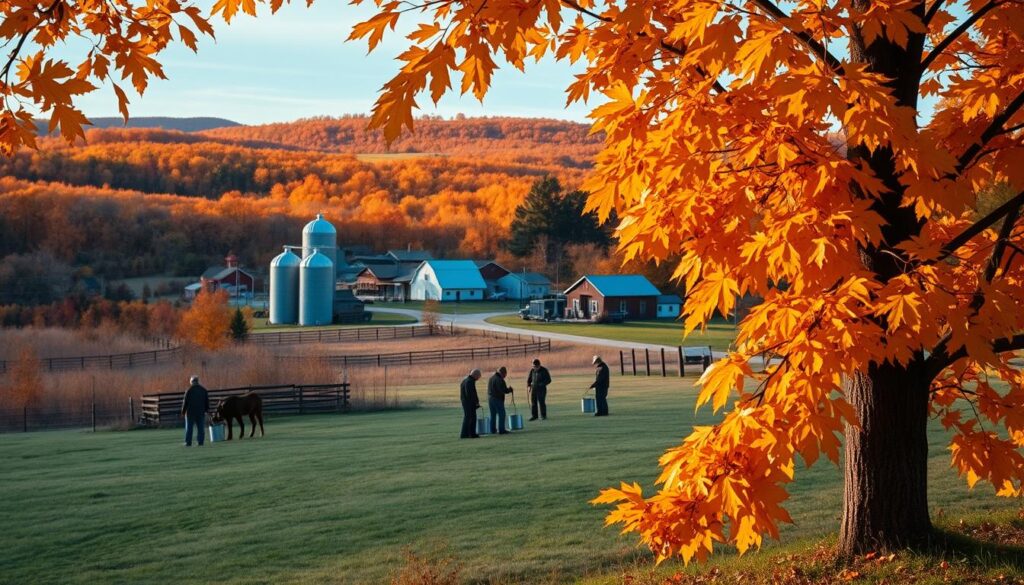
Michigan’s maple syrup industry is a big deal for rural areas. It brings in a lot of money and creates jobs in farming and other fields.
Here are some key ways maple syrup helps Michigan’s economy:
- It brings in over $14 million each year.
- About 300 maple syrup producers work in the state.
- It creates jobs in rural areas.
- It boosts local tourism and farming.
Small family farms are key to Michigan’s farming scene. They make money selling maple syrup online. They also help keep Michigan’s culture and economy diverse.
Maple syrup festivals and farm tours draw visitors from all over. This brings more money to local areas.
“Maple syrup isn’t just a product—it’s an economic engine for Michigan’s rural regions,” says agricultural economist Dr. Sarah Thompson.
Michigan invests in maple syrup producers. It helps them with technical skills, marketing, and keeping forests healthy. This makes the maple syrup industry stronger.
Where to Buy Pure Michigan Maple Syrup
Looking for authentic Michigan maple syrup is a fun journey. Local farmers’ markets are the best place to find it. They connect you with sugarmakers who have been making syrup for years.
There are many great ways to buy this sweet treat:
- Direct farm purchases in Michigan’s maple regions
- Specialty food stores specializing in local products
- Online marketplaces featuring artisan maple syrup producers
- Community cooperative markets
When you’re looking for top-notch maple syrup, keep these tips in mind:
- Look for certified Michigan producers
- Check for organic certifications
- Verify product grade and transparency
- Read customer reviews carefully
Shopping online for maple syrup is now super easy. Websites have detailed info about the syrup you’re buying.
Supporting local Michigan maple syrup producers means enjoying fresher, more authentic products while contributing to regional agricultural traditions.
Pro tip: Always check the producer’s credentials and ask local food lovers for tips. This way, you’ll get the best maple syrup experience.
Supporting Local Michigan Syrup Producers
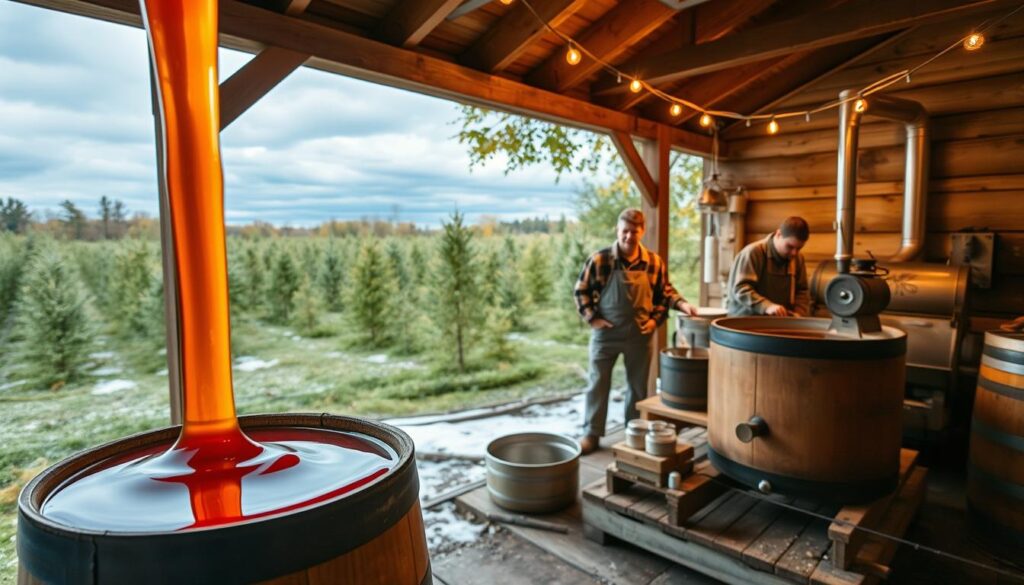
Buying local Michigan maple syrup is more than a simple transaction. It’s a way to keep a valuable farming tradition alive. It connects buyers with the farmers who turn tree sap into syrup.
Supporting local producers brings many benefits:
- Ensures fresher, higher-quality michigan maple syrup
- Directly supports small family-owned sugar bush operations
- Reduces carbon footprint through local sourcing
- Helps maintain Michigan’s rich maple syrup heritage
There are many ways to support these producers:
- Visit local maple syrup festivals
- Participate in sugar bush tours
- Purchase directly from farm stands
- Join community-supported agriculture (CSA) programs
Agritourism offers a unique chance to see how michigan maple syrup is made. Sugar bush operations open their doors during maple season. They give tours that show both old and new ways of making syrup.
Choosing local maple syrup is more than just buying syrup. It’s an investment in Michigan’s farming community. It helps keep a craft alive that has been passed down through generations.
Conclusion
Pure Michigan maple syrup is more than a tasty condiment. It’s a symbol of a deep cultural heritage in the Great Lakes area. The process from tapping the maple trees to enjoying it at home shows the hard work of local makers.
Looking into Michigan maple syrup online opens up a world of genuine, top-notch products. Each bottle shares a story of careful picking, old-fashioned methods, and a dedication to keeping a valued farming tradition alive. This tradition connects us to the earth.
Choosing pure Michigan maple syrup helps local farmers, brings you amazing food quality, and keeps a long-standing tradition alive. It’s perfect for topping pancakes, adding to fancy recipes, or enjoying on its own. Michigan maple syrup gives you a taste of the state’s rich natural heritage.
As people value handmade food more, Michigan maple syrup shines as a top, locally made treat. It shows the finest of American farming skills. The future of this sweet tradition is bright, with dedicated makers innovating while honoring the old ways that make Michigan maple syrup a true culinary gem.

